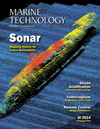
Page 74: of Marine Technology Magazine (March 2014)
Instrumentation: Measurement, Process & Analysis
Read this page in Pdf, Flash or Html5 edition of March 2014 Marine Technology Magazine
The active panels impart and absorb wave energy to induce and reduce the waves; permitting the creation of differ- ent headings, wave-heights, periodicity and event ?focused wave events? not found naturally in the ocean environ- ment. As part of the demonstration, a crowd-pleasing, not-found-in-nature ?donut wave? was generated. ?The control we have over these waves is amazing,? Arcano said. ?For both in-service and future ships, we can test here in a small scale in our basin and identify safe operating envelopes for our ships and validate the environments that the ship might operate in.Arcano said that Carderock has per- formed hydrodynamics testing on virtu-ally every single ship platforms in the Navy eet in the MASK facility. ?The modeling and simulation, testing and design of almost every Navy ship all started here at Carderock. We have been able to validate the designs and dramati- cally reduce risk,? Arcano said. ?We?re looking forward to testing the new ship designs here.? According to Jon Etxegoien, head of naval architecture and engineering de- partment, Carderock engineers and sci-entists will use the new MASK facility along with the 3,000 foot high speed and deep water towing basins and the Large Cavitation Channel in Memphis to study advanced hull forms and ship designs for seakeeping studies and survivability at sea. ?There?s a small degree of over- lap, but each facility has its own unique features.? ?We?ll do straight line testing for re- sistance and power in our long basins. We can test the hull for response ampli- tude with uniform waves, then start in- creasing the period or height and look-ing at how the ship reacts to that,? said Etxegoien. ?But here we can conduct maneuvering and control to evaluate a hull?s seakeeping qualities. We can see how it reacts to different sea conditions.? ?We used to mount the models on the carriage and run them at different head- ings into a sea, obliquely to a sea, or with a following sea. Now, with new wave maker, we can actually control the angle of the waves. We can simulate a more natural sea state, such as wind-driven seas with a swell from one direction. If we expect a ship to be deployed to an area with a lot of big swells we can test and see how that design will handle that situation, and see how it responds to re- ally adverse situations,? said Etxegoien. When Carderock engineers evaluate hull designs, they rst build a computer model. Then they conduct testing with scale models, which informs the model. Then they test in real conditions, and reality informs both. ?With new wave- maker, we can test and make sure our simulations are good,? said Etxegoien. The new system will make testing simpler, Etxegoien said. ?It used to be Facilities March 2014 74 MTRMTR #2 (66-81).indd 74MTR #2 (66-81).indd 742/24/2014 9:49:20 AM2/24/2014 9:49:20 AM

 73
73

 75
75
